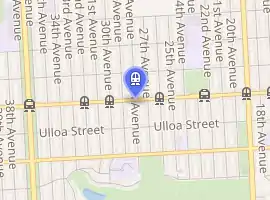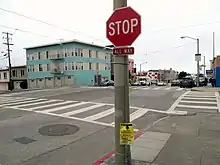Taraval and 28th Avenue station
Taraval and 28th Avenue was a light rail stop on the Muni Metro L Taraval line, located in the Parkside neighborhood of San Francisco, California. The station opened with the first section of the L Taraval line on April 12, 1919; irregular shuttle service had run on a United Railroads line since around 1907. Service to the station was discontinued on February 25, 2017 as part of the L Taraval Rapid project.
.jpg.webp) An inbound streetcar stopped at 28th Avenue in 1980 | |||||||||||
| Location | Taraval Street at 28th Avenue San Francisco, California | ||||||||||
| Coordinates | 37.74263°N 122.48534°W | ||||||||||
| Owned by | MUNI | ||||||||||
| History | |||||||||||
| Opened | c. 1907 (URR) April 12, 1919[1] | ||||||||||
| Closed | February 25, 2017 | ||||||||||
| Former services | |||||||||||
| |||||||||||
| Location | |||||||||||

| |||||||||||
History
Around 1907, the private United Railroads (URR) opened its Parkside Shuttle line, which split from the #17 line on 20th Avenue and ran along Taraval Street, 33rd Avenue, Vicente Street, and 35th Avenue.[2] This trackage, which saw irregular passenger service, formed a barrier to continued expansion of the city-owned Municipal Railway into the Parkside district. On November 25, 1918, the city and the private URR signed the "Parkside Agreements", which allowed Muni streetcars to use URR trackage on Taraval Street and on Ocean Avenue in exchange for a cash payment and shared maintenance costs.[1]:74 Muni's L Taraval line opened to 33rd Avenue (on rebuilt URR trackage west of 20th Avenue) on April 12, 1919.[1]:75 The URR discontinued their Parkside Shuttle in late 1927.[3]
Closure

Like many stations on the line, Taraval and 28th Avenue had no platforms; trains stop at marked poles before the cross street, and passengers crossed travel lanes to board. In March 2014, Muni released details of the proposed implementation of their Transit Effectiveness Project (later rebranded MuniForward), which included a variety of stop changes for the L Taraval line. The stops at 28th Avenue would be moved to the far side of the cross street as boarding islands, with a traffic signal with transit signal priority replacing the existing stop signs to prevent trains from stopping twice.[4]
On September 20, 2016, the SFMTA Board approved the L Taraval Rapid Project. Construction will occur from 2018 to 2020.[5][6] Early implementation of stop eliminations and other changes, including the closure of the 28 Avenue stop due to its proximity to the 26th Avenue and 30th Avenue stops, occurred on February 25, 2017.[7] A small accessible high-level platform will be constructed at 28th Avenue to serve outbound trains; however, it will functionally be part of the 30th Avenue stop rather than a separate stop.[8]
References
- Perles, Anthony (1981). The People's Railway: The History of the Municipal Railway of San Francisco. Interurban Press. p. 75. ISBN 0916374424.
- Chevalier, August (1911). "The "Chevalier" Map of San Francisco" – via David Rumsey Map Collection.
- Stindt, Fred A. (October 1990). San Francisco's Century of Street Cars. p. 119. ISBN 0961546514.
- "Chapter 3: Proposals by Route". Transit Effectiveness Project Implementation Workbook (PDF). San Francisco Municipal Transportation Agency. March 24, 2014. pp. 60–62.
- Rodriguez, Joe Fitzgerald (September 20, 2016). "SFMTA approves controversial L-Taraval changes in name of safety". San Francisco Examiner. Retrieved September 11, 2017.
- "L Taraval Rapid Project Approved by SFMTA Board" (Press release). San Francisco Municipal Transportation Agency. September 20, 2016.
- Hyden, Rachel (February 17, 2017). "More Muni Forward Service Improvements Roll Out February 25" (Press release). San Francisco Municipal Transportation Agency.
- "L Taraval Proposal Detail" (PDF). San Francisco Municipal Transportation Agency. 2016.
External links
![]() Media related to Taraval and 28th Avenue station at Wikimedia Commons
Media related to Taraval and 28th Avenue station at Wikimedia Commons